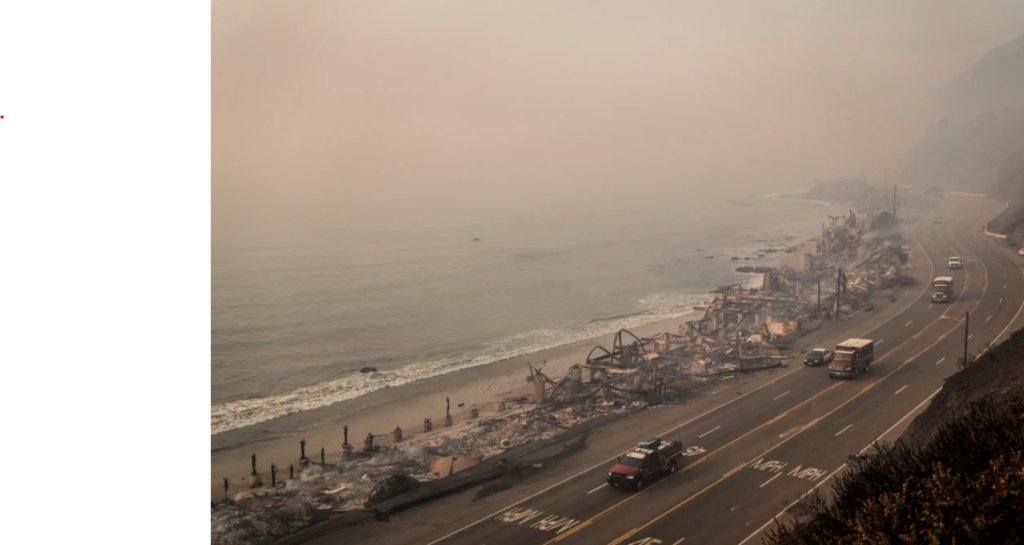
The infernos that have scorched the hills of Los Angeles leave behind more than just charred landscapes and displaced communities—they introduce a silent crisis unfolding beneath the waves. As wildfires rage through Southern California, sending plumes of smoke into the sky and reducing vegetation to ash, researchers are turning their attention to the coastal waters, where runoff from burned terrain carries a toxic cocktail of chemicals into the ocean. The aftermath of these disasters raises a pressing question: How much damage do wildfires inflict on marine ecosystems?
Toxic Runoff and Ocean Health
Following a wildfire, rain can sweep debris, heavy metals, and harmful chemicals from burned areas into local waterways, eventually depositing them into the Pacific. This runoff includes everything from polycyclic aromatic hydrocarbons (PAHs) to trace metals like lead and arsenic, which originate from the combustion of buildings, vehicles, and vegetation. Scientists worry that these pollutants could have devastating consequences for marine life, particularly in coastal areas where surfers, swimmers, and marine species interact closely with the environment.
“We’re dealing with a complex mix of organic and inorganic contaminants that can persist in marine ecosystems long after the flames are extinguished,” says Dr. Julie Dinasquet, an associate project scientist at the Scripps Institution of Oceanography, “The concern is not just immediate toxicity but long-term bioaccumulation in fish and other marine organisms.”
Impact on Marine Life
Once in the ocean, wildfire debris can disrupt delicate ecological balances. Excess nutrients from ash can trigger harmful algal blooms, leading to oxygen-depleted zones that suffocate fish and other aquatic life. In addition, sediment-laden runoff can smother coral reefs, kelp forests, and seagrass beds—critical habitats for countless marine species.
Recent studies suggest that pollutants from wildfire ash can weaken the immune systems of marine organisms, making them more vulnerable to disease. Some toxins, such as dioxins and furans, can persist for years, accumulating in the food chain and potentially affecting human health through seafood consumption.
Risks to Surfers and Swimmers
For those who frequent the waters off Los Angeles, the risks extend beyond environmental damage. After heavy rainfall, health officials often issue warnings advising against ocean recreation due to high bacteria levels and contamination from urban runoff. Wildfire runoff only intensifies these concerns.
Surfers who brave post-rain waters may expose themselves to an array of pathogens and toxic substances. “After major fires, we see an increase in ear infections, skin rashes, and respiratory issues among surfers and beachgoers,” says Dr. Kelly Reynolds, a professor and chair of the Community, Environment & Policy Department at the University of Arizona. “The combination of wildfire ash, sewage overflow, and urban pollutants creates a dangerous mix.”
What Can Be Done?
Scientists and environmental groups are working to mitigate the effects of wildfire runoff on coastal waters. Restoration efforts, such as replanting vegetation in burned areas, help stabilize soil and reduce erosion. Additionally, advances in water filtration and stormwater management can help capture pollutants before they reach the ocean.
Policymakers are also advocating for stricter regulations on land development in fire-prone areas, recognizing that urban sprawl contributes to increased wildfire intensity and runoff pollution. Meanwhile, local organizations encourage community action through beach cleanups and water monitoring initiatives.
A Call for Further Research
While scientists are making strides in understanding wildfire-related ocean pollution, much remains unknown. The interplay between wildfire debris, marine chemistry, and ecosystem health is complex, requiring long-term studies and innovative monitoring techniques.
“Wildfires are becoming more frequent and intense due to climate change, and we need to adapt our research efforts accordingly,” says Dr. Dinasquet. “The more we understand about these impacts, the better we can protect both marine life and the people who depend on these waters.”
As the Los Angeles region continues to recover from devastating wildfires, the battle to protect the ocean is just beginning. By investing in research, sustainable land management, and proactive conservation efforts, we can help ensure that the damage from wildfires does not extend indefinitely into our marine environments.
